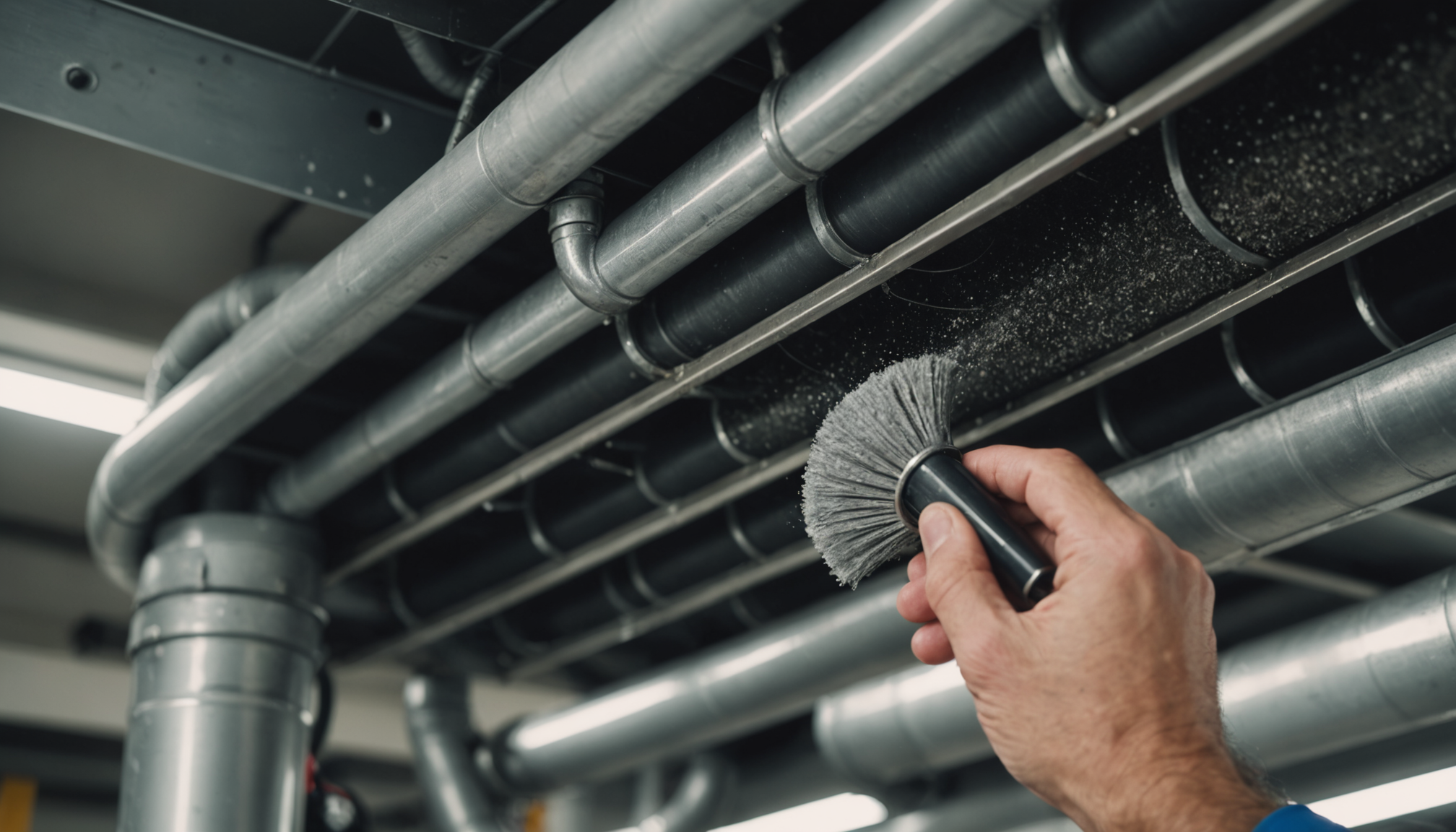Air quality is an often-overlooked aspect of home care, yet it plays a crucial role in maintaining a healthy indoor environment. At the heart of this concern lies the need for duct cleaning, a fundamental part of ensuring that your home’s HVAC system operates efficiently and healthily. Duct cleaning is the process of removing dust, debris, and other contaminants from the ductwork of your heating, ventilation, and air conditioning system. This service is essential because, over time, ducts can accumulate significant amounts of dust and allergens, which may circulate through your home, potentially compromising indoor air quality.
The basic premise of duct cleaning involves a thorough cleaning of various heating and cooling system components, which may include supply and return air ducts and registers, grilles and diffusers, heat exchangers, heating and cooling coils, and drip pans. Without regular cleaning, these components can become breeding grounds for microbial growth, such as mold spores and other allergens, thereby affecting not only system performance but also the health of those living within the home.
One might ask, how does ensuring clean ducts impact HVAC operation? Well, cleaner ducts mean that the system doesn’t have to work as hard to maintain your desired temperature settings. This can lead to more energy efficiency and potentially lower energy costs. Moreover, proper duct maintenance can prolong the life of the HVAC system, warding off the costly repairs or replacements that may occur due to neglected components.
Understanding what your duct cleaning service should entail helps you make informed decisions about maintaining your HVAC system. Standard procedures typically involve assessing the system and using specialized tools to dislodge dirt and debris, followed by a high-powered vacuum to extract them. Depending on your home and system, some additional steps might be included to ensure everything is thoroughly cleaned.
| Cleaning Task | Frequency | Importance |
| Duct Vacuuming | Every 3-5 years | High |
| Grille and Diffuser Cleaning | Annual | Medium |
| Coil Cleaning | Every 2-3 years | High |
In understanding the basics of duct cleaning, it is also essential to be aware of the different methods employed by service providers, as these can affect both efficacy and cost. The two primary methods are source removal and steam cleaning. Source removal is the most recommended because it is highly effective in destroying dust mites, allergens, and microbial contamination.
Given the diverse nature of homes and HVAC systems, local regulations, and environmental conditions, it’s prudent to consult with a professional to determine the best course of action for your needs. A clear comprehension of duct cleaning not only enhances your home care routine but ensures optimal air quality, energy efficiency, and system longevity.
Factors influencing service costs
Several critical factors can influence the cost of duct cleaning services for homeowners, and understanding these elements can help you better anticipate potential expenses. Here’s a detailed guide on what can affect pricing:
- Size of the System:
The size and complexity of your HVAC system play a significant role in determining the cost of duct cleaning. Larger homes with extensive ductwork require more time and effort to clean, potentially increasing the overall price. To estimate costs more accurately, you can measure the square footage and the number of vents or registers in your home.
- System Accessibility:
If your ductwork is difficult to access, such as in tight attic spaces or behind walls, it may increase the labor required, thus raising costs. The available access points and how easily technicians can navigate the system contribute to the overall expense.
- Level of Contamination:
Ducts that have not been cleaned for an extended period or are heavily contaminated with mold, dust, or rodent infestations often demand more intensive cleaning methods. This could involve additional treatments, such as antimicrobial sprays or specialized filters, which can increase costs.
- Type of Cleaning Method:
Different duct cleaning companies use various methods to clean HVAC systems. Methods like source removal, which uses advanced equipment to thoroughly clean, might be more expensive than basic vacuum cleaning. Also, steam cleaning or the use of eco-friendly products can vary in price.
- Regional Prices and Service Availability:
The cost of living in your area or the local market demand for duct cleaning services can impact pricing. For instance, urban areas might see higher prices due to increased operational costs, whereas rural locations may offer cheaper rates but might have fewer service providers to choose from.
- Additional Services:
Some homeowners opt for extra services such as dryer vent cleaning, sanitization, or HVAC maintenance checks, all of which come with additional charges. Understanding which services are essential to your home care can help manage costs efficiently.
Taking these factors into account can provide a clearer understanding of what influences duct cleaning costs and help you select the best options for your home, balancing cost, quality, and the impact on your home’s air quality.
Average pricing breakdown
When considering the expected expenses for a duct cleaning service, homeowners can gain clarity by examining average pricing structures and what typically influences these numbers. Understanding these cost elements not only aids in budgeting but also ensures you receive fair pricing for services rendered.
Duct cleaning service costs can vary widely, typically ranging from $300 to $500 for an average-sized home. The price can dip below or exceed this range depending on several factors, such as the size of the home, the number of ducts, and the level of contamination present in the HVAC system. Larger homes with more extensive ductwork or multiple systems can see costs climbing significantly higher, while simpler systems in smaller residences may require a lower investment.
In addition to the size of the system, another critical price determinant is the degree of contamination within the ducts. If the ductwork hasn’t been cleaned in many years, excessive dust buildup or contamination from mold or pests might necessitate more intensive cleaning efforts, which would naturally incur higher costs. These situations might also call for specialized treatments, such as antimicrobial sprays, which further add to the expense.
The pricing structure can also be influenced by regional variations. Living in an area with a higher cost of living, or a market where professional cleaning services are in high demand, could mean steeper fees. Conversely, rural areas might offer more economical options, though the availability of service providers could be limited.
Accessibility of the ductwork is another element that can impact pricing. Systems installed in hard-to-reach locations or with limited access points may require additional effort and time from technicians, potentially increasing the total cost.
Lastly, additional services, like dryer vent cleaning or HVAC system checks bundled with duct cleaning, can raise the final invoice. While these add-ons come with extra charges, they often offer value by enhancing the overall efficiency of the home’s ventilation system and improving air quality.
Armed with knowledge of these pricing components, homeowners are better equipped to make informed decisions about duct cleaning services. Balancing cost with quality and the positive impacts on both air quality and system longevity ensures peace of mind for those committed to improving their home environments.
Benefits of regular duct maintenance
Regular maintenance of your home’s duct system comes with a host of benefits that significantly enhance both the environment and efficiency of your living space. First and foremost, routine duct cleaning greatly improves the indoor air quality of your home. Over time, dust, dirt, and allergens accumulate in air ducts, which can recirculate every time your HVAC system is in use. By keeping your ducts clean, you minimize the presence of these contaminants, thereby reducing the risk of allergy flare-ups and improving the overall quality of the air you and your family breathe.
Another crucial benefit of regular duct maintenance is improved HVAC efficiency. When air ducts are clogged, your heating and cooling systems must work harder to circulate air throughout your home. This not only increases the energy consumption and cost but can also lead to premature wear and tear on your HVAC components. By maintaining clean ducts, you enable the system to function more efficiently, potentially lowering your energy bills and extending the lifespan of your HVAC system.
Moreover, clean air ducts contribute to a cleaner living environment. With less dust circulating through the air, you’ll notice a reduction in the amount of dust settling on furniture and floors, allowing for easier and less frequent cleaning tasks around the house. This preventative approach to home care means you can spend less time dusting and more time enjoying your living space.
Duct maintenance also plays a crucial role in enhancing the safety of your home. Debris and dust trapped in air ducts can sometimes pose a fire hazard if left unchecked. Ensuring that your duct system is regularly cleaned helps avert this risk, providing peace of mind that your home is not vulnerable to such unexpected incidents.
Finally, regular duct cleaning can have beneficial impacts on the health and comfort of your household. Poor air quality in a home can aggravate respiratory issues and worsen conditions such as asthma and allergies. Clean ducts mean cleaner air and, consequently, fewer health-related discomforts. This is particularly important in homes with young children, the elderly, or anyone with pre-existing respiratory concerns.
Considering the multiple advantages, investing in regular duct cleaning services is a sensible decision that adds value by boosting air quality and energy efficiency. For those looking to find reliable local service providers, LocallyFind.com is an excellent resource. Their comprehensive directory of home service professionals makes it easy to locate trustworthy and experienced duct cleaning experts in your area, ensuring your home remains a safe and comfortable haven for you and your loved ones.
Tips for choosing the right service provider
When selecting a duct cleaning provider, several key considerations can help ensure you choose a reliable and effective service. First, verify the credentials of prospective companies. It’s essential to choose a provider that is certified by recognized organizations, such as the National Air Duct Cleaners Association (NADCA), which sets industry standards for cleaning practices. A NADCA certification indicates that the company adheres to established best practices and possesses the technical know-how to deliver quality cleaning services within your home.
Experience is another critical factor in determining a provider’s capability. Companies with years of practice often have a proven track record of delivering satisfactory services. They are more likely to handle complex situations, such as dealing with older systems or unusual duct setups. Additionally, experienced providers tend to have optimized their methods and equipment, increasing efficiency and effectiveness.
Requesting references or checking online reviews is advisable to understand the experiences of other customers. Customer feedback can provide insights into the quality of workmanship and customer service you might expect. Pay close attention to reviews that mention air quality improvement and overall satisfaction after the service, as these are direct indicators of the company’s performance.
Price, while significant, should not be the sole determining factor. Extremely low-cost quotes may be tempting but often suggest the use of subpar equipment or incomplete cleaning processes, which can compromise the effectiveness of the service. Instead, look for companies that offer detailed cost estimates and clear breakdowns of what their service includes. This transparency helps you understand what you are paying for and ensures there are no hidden fees.
Another important aspect is whether the company provides a detailed inspection and offers customized services tailored to your specific duct system and home needs. Providers that take the time to inspect and assess your HVAC system and make recommendations based on your unique circumstances are likely more invested in achieving high-quality results.
Inquire about the equipment and cleaning techniques used by the service provider. Ensure that they employ advanced and maintained equipment that operates efficiently without damaging your ductwork. A proper duct cleaning service should thoroughly clean components such as fans, coils, and housing compartments, not just the visible areas.
Lastly, consider the provider’s customer service. Responsive and professional communication signifies a company that values its clients and is willing to address any concerns or questions you may have throughout the duct cleaning process. A good service provider clearly answers your questions and keeps you informed at every step.
Choosing the right duct cleaning service is paramount for maintaining a healthy and efficient home. By placing emphasis on these crucial factors—such as certification, experience, customer reviews, transparency in pricing, and quality of service—you can confidently select a provider that meets your home care needs, contributing to better air quality and a more comfortable living environment.
In conclusion, ensuring your home’s ductwork is regularly and professionally maintained brings significant advantages, from improved indoor air quality to more efficient HVAC operation. By understanding the basics of duct cleaning and the factors that influence costs, homeowners can better navigate their options. Selecting a reputable and experienced service provider plays a critical role in achieving these benefits, ultimately enhancing the comfort and health of your living space.


